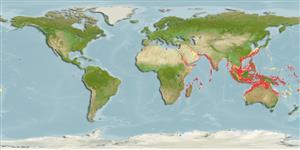Common names from other countries
分類 / Names
共通名の | 類義語 | Catalog of Fishes(部類, 種) | ITIS | CoL | WoRMS | Cloffa
Environment: milieu / climate zone / depth range / distribution range
生態学
海 底生の; 深さの範囲 24 - 204 m (Ref. 9494). Tropical
Indo-West Pacific: Persian Gulf to Taiwan.
サイズ / 重さ / 年齢
Maturity: Lm ? range ? - ? cm
Max length : 60.0 cm SL オス/雌雄の選別がない; (Ref. 48637)
Eyes contiguous, or nearly so (Ref 9895).
Inhabits silty or muddy substrates in coastal waters to about 25 meters depth. Usually deeply burried in the substrate during the day, but out and hunting at night (Ref. 48637).
Life cycle and mating behavior
Maturities | 繁殖 | Spawnings | Egg(s) | Fecundities | 幼生
Menon, A.G.K., 1977. A systematic monograph of the tongue soles of the genus Cynoglossus Hamilton-Buchanan (Pisces: Cynoglossidae). Smithson. Contrib. Zool. (238):1-129. (Ref. 5297)
CITES (Ref. 128078)
Not Evaluated
Human uses
水産業: 興味がない
用具
特記事項
XMLをダウンロードして下さい
インターネットの情報源
Estimates based on models
Preferred temperature (Ref.
115969): 20.5 - 28.1, mean 26 (based on 915 cells).
Phylogenetic diversity index (Ref.
82804): PD
50 = 0.5000 [Uniqueness, from 0.5 = low to 2.0 = high].
Bayesian length-weight: a=0.01514 (0.00592 - 0.03870), b=3.00 (2.77 - 3.23), in cm Total Length, based on LWR estimates for this (Sub)family-body shape (Ref.
93245).
栄養段階 (Ref.
69278): 3.6 ±0.4 se; based on size and trophs of closest relatives
回復力 (Ref.
120179): 手段, 1.4年~4.4年の倍増期間の最小個体群 (Preliminary K or Fecundity.).
Fishing Vulnerability (Ref.
59153): Moderate to high vulnerability (49 of 100).
